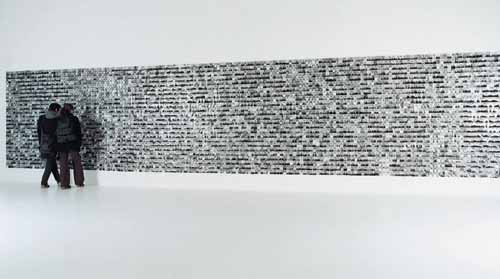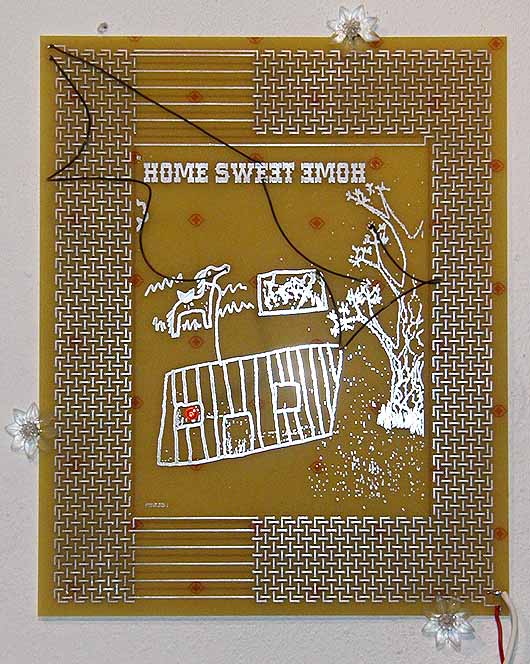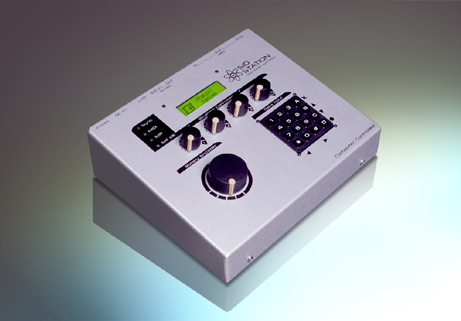View current page
...more recent posts
From the movie One Hour Photo: stalker/artist Robin Williams contemplates his family snapshots. Ten years of the Yorkin family, all palmed at the photomat where he works:

As I recall, Joe Bob Briggs called Tom Noonan in Manhunter "the only psycho with a full time art director." Move over, Tom.
This comes up because we've been discussing the "Mapping Sitting" show at the Grey Art Gallery. Two contemporary artists, Walid Raad and Akram Zaatari, working solidly in the Western post-colonial/conceptualist mode, present hundreds of photos made by a Lebanese commercial photography studio from roughly 1950-1990. This is supposed to repair Western ignorance of the real Middle East*--presumably all at one gulp. Bill says the grid reminds him of the freshman class pictures in the National Lampoon high school yearbook, which were reproduced so small no one could see them. I thought of Robin Williams' masterpiece in One Hour Photo. The grid at the Grey sure looks arty from the installation shot--the artists (one based in Beirut and one in NY/Beirut) appear to have captured, appropriated, and neutralized all this historical commercial (i.e. non art) work with their eye-boggling grid. Also colonized it in the sense of taking it over and presenting it as their own (nothing wrong with that but let's get it on the table), and exoticized it in the sense of why are we having this show if it isn't about consuming "non-Western" experience. I realize I'm critiquing an installation shot--maybe the actual work is more meaningful.**

*From the website: "Collectively, the images convey the pluralistic and multifaceted communities captured by indigenous photographers—images far different from photos of the region circulating widely in the popular press today. In Mapping Sitting, Raad and Zaatari reveal how Arab portrait photography not only pictured individuals and groups, but also functioned as commodity, luxury item, and adornment. Concentrating on commercial images, the exhibition not only raises questions about portrait photography in the Middle East, but also about portraiture, photography, and visual culture in general."
**Update: toc says in the comments: "with his work as 'the atlas group' raad often works with 'historical' documents that he creates himself, rather than true objets trouvés. an installation of automobile motors left over from car bombings in beirut is really just a collection of whatever motors raad can find in the city hosting the exhibition. i haven't seen 'mapping sitting', but i suspect there's something more going on than the worthy politics/august sander ethnography that is presented in the marketing materials." It would certainly be more interesting if the Lebanese portrait studio turned out to be fiction but somehow I don't see NYU (Grey) participating in a hoax. If anyone knows the real story I'll be happy to post it.
From Paul Slocum:
I made a couple of new things for the show, these circuit board pieces. I found a way to translate bitmap images into the circuit design program I was using, and converted actual and recreated images that I had made in elementary and jr. high school. The drawings are rendered in tin-plated copper on standard circuit board material. And the drawings are integrated with very simple circuits that illuminate LEDs and a neon lamp.

As I've mentioned a few times, I recently acquired jenghizkhan's Sidstation synthesizer, which incorporates a working vintage sound chip from the Commodore 64, the "legendary" home computer used by many geeks and/or gamers in the '80s. The Swedish company Elektron built only about a 1000 Sidstations due to a limited supply of the chips--it recently found another 100 and the machines were sold just like that. A Macintosh SE user back in the day, I have no attachment to the Commodore and am actually not that interested in recreating game sounds per se, but I am intrigued by the manufacturer's claim that the hacker community explored every permutation and limitation of the chip's sound-making potential, or words to that effect. How many products can you say that about? And in any case, the Sidstation is more than just a chip, it's a full blown synth with many levels of programming and some incredibly interesting full bodied, but all fairly dirty and noisy, sounds.
I'm taking my time about plunging into the inner mysteries of this instrument. Changes to presets or "patches" are done on a tiny LCD screen--with only slightly more characters than a cell phone. I've been exploring the patches that came with it, changing settings and sounds with the machine's few knobs and running various sounds and MIDI files (including my tunes) through it--all the while teaching myself more about the rudiments of synthesis from books, as well as some other hardware with more buttons to push and dials to turn. Also, I've been nervous about crashing it and not knowing what to do next. jenghiz sold it to me with about 90 presets and a CD that I thought had only back-up files. I was a little disappointed that so many of the patches were sequences--i.e., someone else's tunes that you could use like an arpeggiator to play under, or triggered by, your own melodies.
Getting to the point of my story, I crashed the machine the other night. The patch database was completely locked up, so I had to erase all the presets. I downloaded MIDI-OX, which is a MIDI file managing program, to my PC and opened up the CD. Lo and behold, there were several hundred more patches on the CD I didn't even know I had. I successfully did a MIDI dump and reloaded the Sid with about 90 new voices, most of which are not sequences! It feels like Christmas around here. I know the hackers are laughing but give me my simple pleasures. Eventually I'll have my real rite of passage and start seriously tweaking these patches.

For a later time: why are sounds so much more interesting to me than all the colors and textures of Photoshop, et al? I've gone deeper into sound technology in the past six months than I've gone in years of working with imaging software. With the latter I always felt (and still feel) like I could do everything I wanted to do with just the rudiments: 256 colors and a few basic tools.
Oh, hell, I'll go ahead and attempt to answer this. First, I can draw and paint pretty well (I'm about to choke on this modesty) so I don't feel I need the tech to augment my skills, whereas I am only an adequately dextrous musician and thus more dependent on the tech to make music I can hear but not necessarily play. (Just for the record: hand skill is not a requisite for any art but might have a bearing on relative levels of confidence or cockiness.) But I think even more important than the dexterity issue, electronic music hooks me more on a gut, emotional level than electronic art: I prefer it more as a consumer and am therefore more willing to learn about it as a producer. Ouch, I said it. But then, I've cycled back and forth between dj'ing/music crit and studio art/crit since college days so this is probably just a phase. OK, that's about all the autobiography this blog can stand.
"The Star Pools" [4.2 MB .mp3]
